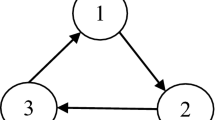Abstract
Influence maximization problems aim to identify key players in (social) networks and are typically motivated from viral marketing. In this work, we introduce and study the Generalized Least Cost Influence Problem (GLCIP) that generalizes many previously considered problem variants and allows to overcome some of their limitations. A formulation that is based on the concept of activation functions is proposed together with strengthening inequalities. Exact and heuristic solution methods are developed and compared for the new problem. Our computational results also show that our approaches outperform the state-of-the-art on relevant, special cases of the GLCIP.



Similar content being viewed by others
References
Ackerman, E., Ben-Zwi, O., Wolfovitz, G.: Combinatorial model and bounds for target set selection. Theor. Comput. Sci. 411(44), 4017–4022 (2010)
Ben-Zwi, O., Hermelin, D., Lokshtanov, D., Newman, I.: Treewidth governs the complexity of target set selection. Discrete Optim. 8(1), 87–96 (2011)
Borgatti, S.P.: Identifying sets of key players in a social network. Comput. Math. Org. Theory 12(1), 21–34 (2006)
Chen, N.: On the approximability of influence in social networks. SIAM J. Discrete Math. 23(3), 1400–1415 (2009)
Chen, W., Lakshmanan, L.V., Castillo, C.: Information and influence propagation in social networks. Synth. Lect. Data Manag. 5(4), 1–177 (2013)
Domingos, P., Richardson, M.: Mining the network value of customers. In: Proceedings of the Seventh ACM SIGKDD International Conference on Knowledge Discovery and Data Mining, pp. 57–66. ACM (2001)
Dreyer Jr., P.A., Roberts, F.S.: Irreversible k-threshold processes: graph-theoretical threshold models of the spread of disease and of opinion. Discrete Appl. Math. 157(7), 1615–1627 (2009)
Garey, M.R., Johnson, D.S.: Computers and Intractability: A Guide to the Theory of NP-Completeness. W. H. Freeman, New York (1979)
Granovetter, M.: Threshold models of collective behavior. Am. J. Sociol. 83(6), 1420–1443 (1978)
Grötschel, M., Jünger, M., Reinelt, G.: On the acyclic subgraph polytope. Math. Program. 33(1), 28–42 (1985)
Gunnec, D., Raghavan, S.: Integrating social network effects in the share-of-choice problem. Decis. Sci. 48(6), 1098–1131 (2017)
Günneç, D.: Integrating social network effects in product design. Ph.D. thesis, University of Maryland (2012)
Günneç, D., Raghavan, S., Zhang, R.: Tailored incentives and least cost influence maximization on social networks. Technical report, University of Maryland (2017)
Kempe, D., Kleinberg, J., Tardos, É.: Maximizing the spread of influence through a social network. In: Proceedings of the Ninth ACM SIGKDD International Conference on Knowledge Discovery and Data Mining, pp. 137–146. ACM (2003)
Kempe, D., Kleinberg, J., Tardos, É.: Influential nodes in a diffusion model for social networks. In: Proceedings of the 32nd International Conference on Automata, Languages and Programming, pp. 1127–1138. Springer (2005)
Kempe, D., Kleinberg, J., Tardos, É.: Maximizing the spread of influence through a social network. Theory Comput. 11(4), 105–147 (2015)
Kimura, M., Saito, K., Nakano, R.: Extracting influential nodes for information diffusion on a social network. AAAI 7, 1371–1376 (2007)
Leskovec, J., Adamic, L.A., Huberman, B.A.: The dynamics of viral marketing. ACM Trans. Web 1(1), 1–39 (2007)
Raghavan, S., Zhang, R.: Weighted target set selection on social networks. Technical report, University of Maryland (2016)
Richardson, M., Domingos, P.: Mining knowledge-sharing sites for viral marketing. In: Proceedings of the Eighth ACM SIGKDD International Conference on Knowledge Discovery and Data Mining, pp. 61–70. ACM (2002)
Watts, D.J., Strogatz, S.H.: Collective dynamics of ’small-world’-networks. Nature 393(6684), 440–442 (1998)
Wu, H.-H., Küçükyavuz, S.: A two-stage stochastic programming approach for influence maximization in social networks. Comput. Optim. Appl. 69(3), 563–595 (2018)
Author information
Authors and Affiliations
Corresponding author
Additional information
Supported by WWTF (Project ICT15-014) and MiUR, Italy (Project PRIN 2015).
Rights and permissions
About this article
Cite this article
Fischetti, M., Kahr, M., Leitner, M. et al. Least cost influence propagation in (social) networks. Math. Program. 170, 293–325 (2018). https://doi.org/10.1007/s10107-018-1288-y
Received:
Accepted:
Published:
Issue Date:
DOI: https://doi.org/10.1007/s10107-018-1288-y




